Do you have a penchant for shimmering purple gemstones that have been prized for centuries? Well, you’re in for a treat because in this expert guide, we’re diving headfirst into the world of amethysts! 2023 brings with it exciting opportunities for rockhounds, crystal enthusiasts, and anyone who simply loves the allure of amethyst. Whether you’re a seasoned collector or just starting to explore the world of gemstones, we’ve got you covered. Let’s embark on a journey to discover where to find amethyst and amethyst mines near you in 2023. From the rocky mountains of Colorado to the lush forests of Brazil, the amethyst hunt is on, and we’re here to guide you every step of the way. So, what’s in store for you in this article? Let’s break it down:
Unveiling the Mystique of Amethyst
But first, what exactly is amethyst? It’s not just a pretty purple stone, folks. Dive into the rich history, mystical properties, and scientific facts that make amethyst truly special.
Amethyst has been captivating humans for centuries with its stunning violet hues. Its spiritual and healing properties have made it a favorite among crystal enthusiasts. Want to learn more about the lore surrounding this gem? We’ve got you covered.
What Is Amethyst?
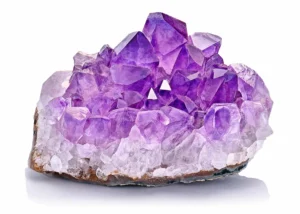
Amethyst, often described as nature’s masterpiece in purple, is a breathtaking gemstone that has enchanted humans for centuries. But what exactly is this mesmerizing mineral?
A Geological Marvel
At its core, amethyst is a variety of quartz, one of the Earth’s most abundant minerals. Quartz, composed of silicon and oxygen, forms under various geological conditions. What sets amethyst apart is its vibrant purple color, ranging from delicate lavender hues to deep, royal purples.
The Purple Power
Amethyst’s captivating coloration is not just a random accident. It owes its regal hue to the presence of iron and other trace elements in its crystal lattice. Interestingly, the degree of purple can vary depending on the specific conditions during its formation. This natural variability gives each amethyst gem its unique charm.
A Journey Through Time
Beyond its geological origin, amethyst carries a rich history intertwined with folklore, spirituality, and mythology. In ancient times, it was believed to ward off intoxication, leading to the Greek origin of its name, “amethystos,” which means “not drunk.” The Greeks and Romans often wore amethyst jewelry and carved drinking vessels from it to prevent overindulgence.
Healing and Spiritual Properties
Amethyst has long been associated with healing and metaphysical properties. It is believed to possess calming energy, promoting balance and harmony. Many individuals use amethyst in meditation, as it’s thought to enhance spiritual awareness and intuition. Some even place amethyst crystals under their pillows for more restful sleep.
Science Meets Beauty
Beyond its historical and mystical significance, amethyst has also captivated scientists and gem enthusiasts. Gemologists and geologists study the unique properties of amethyst, appreciating its intricate crystal structure and the factors influencing its color.
So, in a nutshell, amethyst is not just a pretty purple rock; it’s a geological marvel with a rich history, healing properties of amethyst, and a scientific allure that continues to captivate both seasoned collectors and newcomers to the world of gemstones. Whether you’re drawn to its beauty, its history, or its metaphysical qualities, amethyst is a gem worth exploring and cherishing.
Where Amethyst Is Formed?
Amethyst, with its enchanting purple hues, is a gemstone that forms under specific geological conditions. If you’re curious about where amethyst is born, we’re here to take you on a journey through the Earth’s crust to uncover its secret origins.
Geology 101
Amethyst is a variety of quartz, and like all quartz, it’s composed primarily of silicon and oxygen atoms. What makes amethyst unique is the presence of trace elements, particularly iron, which gives it that gorgeous purple color. But for amethyst to come into being, certain geological factors must align.
Volcanic or Hydrothermal Origins
Amethyst typically forms in two primary geological settings: volcanic and hydrothermal. Let’s break down each one:
- Volcanic Formation: Amethyst can be found in geodes, which are spherical cavities within volcanic rocks. These cavities, often lined with amethyst crystals, are created when gas bubbles are trapped in molten rock during a volcanic eruption. Over time, as the lava cools and solidifies, mineral-rich solutions infiltrate these cavities, depositing amethyst crystals.
- Hydrothermal Formation: In hydrothermal environments, hot water solutions rich in minerals circulate through cracks and fissures in the Earth’s crust. When these solutions come into contact with quartz-rich rocks, they can deposit amethyst crystals. This process can take thousands to millions of years, resulting in amethyst veins within rocks.
Global Hotspots for Amethyst
Now that we understand the geological processes involved, where can we find amethyst? Here are some notable locations:
- Brazil: Brazil is famous for its amethyst deposits, especially in the state of Rio Grande do Sul. The Ametista do Sul mine in Brazil is renowned for producing some of the world’s most exquisite amethyst specimens.
- Uruguay: Uruguay is another South American treasure trove for amethyst, with mines like the Artigas region known for their high-quality gems.
- United States: The USA boasts several amethyst-rich regions, including Arizona, North Carolina, and Colorado. The Four Peaks Amethyst Mine in Arizona, in particular, is a well-known source of deep purple amethyst.
- Zambia: In Africa, Zambia is celebrated for its rich amethyst deposits, and Zambian amethyst is known for its deep, saturated color.
- Russia: The Urals in Russia have also yielded beautiful amethyst specimens, often associated with other gemstones like quartz and fluorite.
The Natural Alchemy
In essence, amethyst is the result of a remarkable natural alchemy involving geological processes, mineral-rich solutions, and the interplay of elements deep within the Earth’s crust. The specific conditions necessary for amethyst formation make it a gem both cherished by collectors and admired for its striking beauty.
So, the next time you hold a piece of amethyst in your hand, remember that it’s not just a gemstone; it’s a geological masterpiece born from the Earth’s depths and patiently crafted over millennia.
Types of Amethyst
Amethyst, with its captivating violet allure, comes in a variety of types and forms, each with its unique characteristics and charm. Whether you’re a seasoned collector or a budding enthusiast, understanding these different types of amethyst can add depth to your appreciation of this enchanting gemstone. Let’s delve into the fascinating world of amethyst variations:
1. Siberian Amethyst
Named after its discovery in Russia’s Siberian region, Siberian amethyst is celebrated for its deep and rich purple color. It often features intense hues that lean towards royal purple. This type of amethyst is highly sought after by collectors due to its stunning beauty and historical significance.
2. Uruguayan Amethyst
Uruguayan amethyst is renowned for its distinct deep purple color, often tinged with hints of red or blue. What makes it stand out is its exceptional transparency and clarity. The amethyst from Uruguay is commonly used for high-quality jewelry pieces, where its vivid color can truly shine.
3. African Amethyst
Amethyst from various African countries, such as Zambia and Namibia, is prized for its exceptional color and size. African amethyst tends to exhibit a deep purple hue with flashes of red and blue, making it a popular choice among gemstone enthusiasts and jewelry designers.
4. Brazilian Amethyst
Brazil has long been a significant source of amethyst, and Brazilian amethyst is known for its wide range of colors. It can vary from light lavender to deep purple. Brazilian amethyst is often used in jewelry and carvings, showcasing its versatility.
5. Green Amethyst (Prasiolite)
Green amethyst, also known as prasiolite, is a unique variation of amethyst. Its color ranges from pale green to olive green due to its exposure to heat. Prasiolite is treasured for its rarity and is often used in distinctive jewelry pieces for its tranquil and refreshing appearance.
6. Chevron Amethyst
Chevron amethyst is characterized by its distinct banded pattern, a result of alternating layers of amethyst and white quartz. This type of amethyst is not only visually striking but also believed to possess enhanced spiritual and healing properties.
7. Brandberg Amethyst
Found in the Brandberg Mountains of Namibia, Brandberg amethyst is known for its unique blend of amethyst, clear quartz, and smoky quartz. It exhibits a range of colors and inclusions, making each specimen a one-of-a-kind masterpiece.
8. Veracruz Amethyst
Hailing from the Veracruz region of Mexico, Veracruz amethyst is prized for its clarity and pale lavender color. It’s often found in clusters and is considered a favorite among collectors for its elegant and delicate appearance.
9. Thunder Bay Amethyst
Canada’s Thunder Bay region is home to an amethyst variety with a pale to medium purple hue. It’s often used for jewelry and carvings, and its unique coloration sets it apart from other types of amethyst.
As you explore the world of amethyst, you’ll discover that each type possesses its own distinctive characteristics, making them alluring in their own right. Whether you’re drawn to the deep purples of Siberian or Uruguayan amethyst, the versatility of Brazilian amethyst, or the rarity of prasiolite, there’s an amethyst variation to suit every taste and style. So, the next time you admire an amethyst, take a moment to appreciate the unique type that makes it truly special.
Where Amethysts Can Be Found and Mined?
Amethyst, with its alluring purple hues, is a gemstone that holds a special place in the hearts of collectors and enthusiasts worldwide. If you’re eager to uncover where amethysts can be found and mined, this section is your treasure map to amethyst-rich regions. We’ll explore two major continents, South America and Africa, each boasting its own share of stunning amethyst mining spots.
Amethyst Mining Spots In The USA
We’ve assembled detailed guides for locating amethysts across numerous U.S. states, and we plan to expand this resource further in the future. If you’re looking for precise hunting spots in each state, you can either click on the map above or refer to the alphabetically organized list below.
Arizona | New York |
Arkansas | Nevada |
California | North Carolina |
Colorado | Ohio |
Georgia | Oregon |
Illinois | Pennsylvania |
Minnesota | South Carolina |
Missouri | Texas |
Wisconsin |
Amethyst Mining Spots in South America
1. Brazil
Brazil is often hailed as the amethyst capital of the world.
- Ametista do Sul: This picturesque town in the state of Rio Grande do Sul is famous for its amethyst mines, particularly the Santa Rita mine. Here, you can explore geodes and witness the enchanting process of amethyst extraction.
- Minas Gerais: Brazil’s Minas Gerais region is renowned for producing amethysts with a wide range of colors, from light lavender to deep purple. The city of Ametista do Sul is home to numerous amethyst mines open to visitors.
2. Uruguay
Uruguay is another South American gem that shines brightly in the world of amethyst.
- Artigas: The Artigas region in Uruguay is celebrated for its high-quality amethyst. Visitors can explore open-pit mines and, if lucky, unearth their very own amethyst treasures. The gems from this region are known for their deep and rich purple color.
Amethyst Mining Spots in Africa
1. Zambia
Africa, too, is a treasure trove of amethyst, and Zambia is a prominent player in the game.
- Kapiri Mposhi: This region in Zambia is famous for producing deep purple amethyst with excellent transparency. The amethyst here is often associated with other minerals like citrine and smoky quartz, creating captivating combinations.
2. Namibia
The Brandberg Mountains in Namibia are a unique source of amethyst, offering a different experience.
- Brandberg Mountain: Located in the Namib Desert, Brandberg Mountain is home to Brandberg amethyst, a distinct variety that combines amethyst, clear quartz, and smoky quartz. The diverse colors and inclusions found here make it a sought-after destination for collectors.
3. Madagascar
Madagascar has recently gained recognition for its amethyst production, particularly in the Anahamena region.
- Anahamena: Amethyst from Anahamena in Madagascar is known for its striking deep purple color. The mines here yield amethyst crystals of various sizes and qualities, making it a promising destination for gemstone enthusiasts.
Whether you’re planning an amethyst-hunting adventure or simply want to admire the beauty of these gem-rich regions, South America and Africa offer an array of opportunities to explore the world of amethyst mining. Each location has its unique characteristics and amethyst varieties waiting to be discovered. So, which continent will you choose for your next amethyst quest?
How to Find Amethyst?
Are you ready to embark on a thrilling adventure to find amethyst, the captivating purple gemstone? Whether you’re a seasoned collector or a novice gem enthusiast, the journey to discover amethyst can be both exciting and rewarding. In this guide, we’ll share valuable tips and techniques on how to find amethyst effectively. So, grab your gear and get ready for a treasure hunt like no other!
Research Amethyst Locations
The first step in finding amethyst is to research its geological distribution. Amethyst can be found on almost every continent, but some regions are renowned for their rich deposits. Popular amethyst locations include Brazil, Uruguay, Zambia, and the United States. Choose your destination based on the type of amethyst you’re seeking and the experience you desire.
Tools of the Trade
Having the right tools is essential for successful amethyst hunting. Here’s a basic toolkit to consider:
- Geological Hammer: A sturdy hammer will help you break rocks and open geodes.
- Chisel: A chisel aids in precision work and splitting rocks.
- Safety Glasses: Protect your eyes from flying debris.
- Gloves: Keep your hands safe from sharp edges.
- Backpack: Carry your tools, water, and snacks comfortably.
- Brush and Magnifying Glass: These are handy for inspecting and cleaning specimens.
Visit Amethyst Mines and Deposits
One of the most straightforward ways to find amethyst is to visit amethyst mines and known deposits. Many of these sites are open to the public, offering guided tours and the opportunity to search for amethyst. Popular mines often have designated digging areas where you can collect your own specimens.
Identify Suitable Rocks and Minerals
Amethyst is often found in association with other rocks and minerals. Learn to identify these geological indicators:
- Quartz: Amethyst is a variety of quartz, so look for quartz-rich rocks and formations.
- Geodes: Amethyst crystals are commonly found inside geodes, spherical cavities in rocks.
- Amethyst Veins: In some locations, amethyst is found in veins within host rocks.
Look for Geological Clues
Observing your surroundings can provide clues about where amethyst may be hiding:
- Rock Layers: Study the layers and strata in rock formations to identify potential amethyst-bearing layers.
- Fissures and Faults: Amethyst often forms in cracks and fissures in rocks, so explore these areas.
- Water Erosion: Water can expose amethyst crystals, so check riverbanks and streambeds.
Be Patient and Persistent
Finding amethyst can be a test of patience. Not every rock or geode will contain amethyst, so persistence is key. Keep searching, and don’t get discouraged if you don’t find amethyst right away.
Respect Local Laws and Environments
Always follow local regulations and obtain any necessary permits for collecting amethyst. Respect the environment by filling in any holes you dig and leaving no trace of your visit.
Safety First
Ensure your safety by wearing appropriate gear and taking precautions when handling rocks. Be cautious when using tools and avoid risky or unstable areas.
With these tips in mind, you’re well-equipped to begin your amethyst-finding adventure. Whether you’re exploring mines or scouring natural formations, the thrill of discovering these beautiful purple gems is a rewarding experience.
The Best Amethyst Mines Near You
If you’re eager to get your hands on some stunning amethyst specimens, you’re in luck! We’ve curated a list of the best amethyst mines near you, each offering a unique and exciting amethyst-hunting experience. Whether you’re a seasoned collector or a first-time adventurer, these mines are sure to spark your gemstone enthusiasm.
Four Peaks Arizona Amethyst Mine

Location: Tonto National Forest, Arizona, USA
What Makes it Special:
- World-Famous Amethyst: The Four Peaks Amethyst Mine is renowned for producing some of the world’s finest amethyst crystals, known for their deep purple hue.
- Stunning Desert Scenery: Enjoy the picturesque beauty of the Tonto National Forest as you hunt for amethyst amidst rugged desert landscapes.
- Visitor-Friendly: The mine offers guided tours and even allows visitors to dig for their own amethyst treasures, making it an ideal spot for enthusiasts of all levels.
Diamond Hill Mine
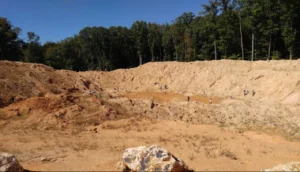
Location: Abbeville County, South Carolina, USA
What Makes it Special:
- Variety of Minerals: While known for its amethyst, Diamond Hill Mine also offers the chance to find other minerals like garnet, beryl, and quartz.
- Family-Friendly: It’s a great destination for families, with a relaxed atmosphere and the option to bring your own tools or rent them on-site.
- Pristine Nature: Explore the serene surroundings and lush greenery of South Carolina while hunting for amethyst crystals.
Jackson Crossroads Amethyst Mine
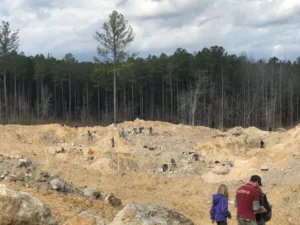
Location: Wilkes County, Georgia, USA
What Makes it Special:
- Deep Purple Amethyst: Jackson Crossroads is famous for its high-quality deep purple amethyst crystals, making it a favorite among collectors.
- Educational Experience: The mine offers educational programs, making it an excellent choice for those who want to learn more about amethyst and geology.
- Year-Round Collecting: Unlike some mines with seasonal access, Jackson Crossroads allows visitors to hunt for amethyst year-round.
Huck’s Lost Mine

Location: Mount Ida, Arkansas, USA
What Makes it Special:
- Diverse Minerals: Huck’s Lost Mine offers not only amethyst but also the opportunity to find other gems like quartz, garnet, and even diamonds.
- Access to Prime Digs: The mine provides access to prime digging spots, increasing your chances of finding high-quality amethyst.
- A Gem-Hunter’s Paradise: Nestled in the beautiful Ouachita Mountains, this location promises a memorable gem-hunting experience.
Emerald Hollow Mine
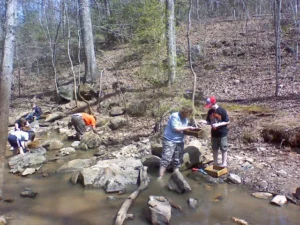
Location: Hiddenite, North Carolina, USA
What Makes it Special:
- Hiddenite Varieties: While known for emeralds, this mine also yields hiddenite, a green variety of spodumene, and amethyst, offering a unique gem-hunting experience.
- Family-Friendly Fun: Emerald Hollow Mine welcomes families, with a sluiceway for gemstone mining that’s perfect for kids.
- Mineral Museum: After your dig, visit the on-site Mineral Museum to learn more about the fascinating world of gems and minerals.
These amethyst mines near you offer not only the chance to unearth exquisite amethyst crystals but also the opportunity to immerse yourself in the beauty of nature and the excitement of treasure hunting. Whether you’re searching for deep purple amethyst in Arizona or exploring the diverse gem treasures of Arkansas, each of these mines promises a memorable adventure for gemstone enthusiasts of all ages. So, grab your gear and get ready to discover the hidden gems of the Earth!
How to Identify Amethyst You Find?
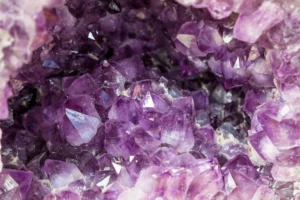
So, you’ve embarked on an amethyst-hunting expedition and uncovered some intriguing rocks and crystals. But how can you be sure that what you’ve found is, indeed, amethyst? In this guide, we’ll show you how to identify amethyst you find by examining its key characteristics.
What Does Amethyst Look Like?
Amethyst is known for its captivating violet to purple coloration, but its appearance can vary based on several factors. Here’s what to look for when identifying amethyst:
Color
Amethyst typically displays shades of purple ranging from pale lavender to deep royal purple. The most prized specimens often have a rich and consistent purple hue. Be cautious of specimens that appear too light, as they may be lower in quality.
Clarity
Amethyst crystals are often transparent to translucent, allowing light to pass through them. Exceptionally clear specimens are highly sought after in the world of amethyst. However, it’s not uncommon to find amethyst with some inclusions or cloudiness, especially in natural formations.
Imperfections
Like all gemstones, amethyst can have imperfections. These include small cracks, fractures, or internal features. Some collectors appreciate the character these imperfections bring, while others prefer flawless specimens.
Hardness
Amethyst belongs to the quartz family and has a hardness of 7 on the Mohs scale. This means it can scratch glass but can also be scratched by harder materials like topaz and diamond. When you’re identifying amethyst, check for hardness by attempting to scratch it with a material of known hardness, like a glass surface.
Cut
Amethyst is often cut into various shapes for jewelry, such as faceted gems or cabochons. If you come across cut amethyst, examine the precision and quality of the cut. Well-cut amethyst should have symmetrical facets and a brilliant sparkle when exposed to light.
Additional Tips for Identification
- Streak Test: Perform a streak test by scratching the surface of your specimen on an unglazed porcelain tile. Amethyst should leave a white streak.
- UV Light: Amethyst can exhibit fluorescence under ultraviolet (UV) light. Shine a UV light on your specimen to see if it fluoresces with a violet or bluish glow.
- Crystal Habit: Amethyst crystals often form in hexagonal prisms with pointed terminations. Look for these distinctive crystal habits when identifying your find.
- Density: Amethyst has a specific gravity of around 2.65, which means it’s denser than most other non-metallic minerals. Compare the weight of your specimen to its volume to estimate its density.
Remember that identifying minerals like amethyst can be a nuanced process, and it may require practice and experience. If you’re uncertain about the authenticity of your find, consider consulting a mineralogist or experienced gemologist for a professional assessment. Happy amethyst hunting.

One Comment